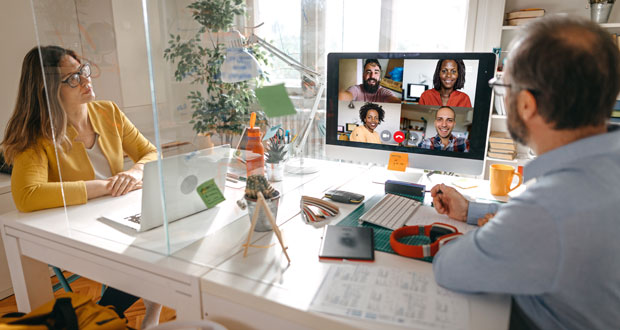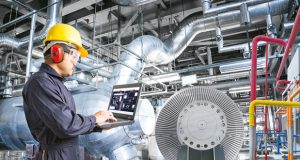How do you see the pandemic influencing workplace layout and interiors? Will the experience of working from home inspire workplace specialists to introduce organic and home interiors-inspired textures and colour palettes? And what kind of solutions do you think will be required to adapt office spaces to support agile working, hot desking and social distancing, while encouraging cross-team working and digital collaboration?
 THE FACILITIES MANAGER’S VIEW
THE FACILITIES MANAGER’S VIEW
TARNIAH THOMPSON,
REGIONAL FM, SHW
With many people away from the office for nearly a year during the pandemic, a big debate has opened up over ‘homeworking’, an option that was previously job dependent. It has seen many companies utilising their break clauses, downsizing their office space and revising their layouts.
Whereas the focus before was on larger spaces with more desks per sq ft, it is now likely to be on fewer desks and more hot desking opportunities. Companies are looking at how best to use their office space to maintain a turn-style based, quick set up working environment.
Internal facilities have become more high tech, including coffee/tea making machines you do not have to touch to operate. Companies are also adopting more of a minimalist, holistic approach, such as increased foliage in work areas. This not only looks great but shows we are taking more notice of the benefits of nature in workplace productivity and mental wellbeing.
There is an element of bringing the working from home environment to work but not in the literal sense; it is making ‘being at work’ comfortable. Do you remember the old corporate furniture stationed in reception areas once upon a time? The standard veneer oak furniture for office desks? Now we are looking at white desks, or black modern types, complemented by a range of colours in break out areas and chairs that are from accessible shops like MADE.com.
I was recently at a tenant’s office for a meeting with a colleague, socially distanced across a boardroom. Their office management team remotely activated the conference system; we were automatically logged in to Microsoft Teams. A large flat screen was in front of us, with remote controlled mics and a hardwired webcam that panned and zoomed whilst me and my colleague spoke to the tenant and his team who were on the call within their homes. I think this kind of set up in offices will be required more to allow for better team collaborations digitally.
For some, working from home is not an option and desk booking will be needed to manage the different levels of office attendance. This will give people the opportunity to change desks and move around the office, not be segregated in desk clusters according to department. Long gone are the days of being hidden away in small offices.
Dependent on one’s home dynamics – whether it be the eerie silence, TV noise, or the continuous chatter of children asking for snacks during your team conference call there is likely to be some degree of acceptance to hybrid working. The office needs to step up if it is to cater for the varying demands of the workforce post COVID.
 OFFICE CONNECTIVITY SPECIALIST’S VIEW
OFFICE CONNECTIVITY SPECIALIST’S VIEW
TIM SHIRT,
KEY ACCOUNT MANAGER, CMD LTD
COVID-19 has changed the way we live and work for good. Employees, even those who are keen to get back into the office, want to bring elements of home comfort back to the workplace.
Employers, meanwhile, want to articulate a caring, nurturing and welcoming environment with a homelier, softer office interior. As a consequence, we can expect to see more use of natural materials and biophilia in office environments, creating a resi-commercial look and feel, with layouts that enable both social distancing and collaboration.
Social distancing will be with us for a while, and it seems unlikely that most businesses will return to allocated workstations for every employee. Electrical distribution systems such as powertrack or power hub, are already widely used in office environments and these will enable spaces to be reconfigured and occupancy to be scaled up or down. The ability to locate a tap off anywhere on the network at 30cm intervals allows versatile layouts, with redundancy and resilience built in where required, and this will play a key role in delivering flexibility as needs change.
As we see a return to the office, booking regimes to enable social distancing and infection control by monitoring who is using which desk have already been implemented in many workplaces. As the virus subsides, these systems are likely to remain for hot desking, which has implications for workstation connectivity, smart technology and on desk equipment. This includes the use of Bluetooth and RFID technologies to allow automated registration of personnel at the workstation and multi-directional sockets for power, charging and connectivity to allow rapid hot desk set-up.
During the pandemic, adapting to new tools and platforms has not only enabled remote working but also collaboration across departments, sites and borders. Consequently, we’re also likely to see an evolution towards more tech-enabled offices to enable continued collaboration in the virtual space.
With a move away from traditional desk layouts towards formal and informal collaborative and quiet working spaces, powerbank or wireless charging functionality built into furniture for break out areas and acoustic meeting/isolation booths will allow workers to take a fluid approach to where they sit and how they work. Apple’s adoption of wireless charging technology has been a game changer in terms of homogenising the tech required for wireless charging of any device. As this technology has become more robust, enabling charging of both phones and tablets, there is a more compelling case than ever for integrating wireless charging within furniture, alongside USB charging and power sockets.
New technology will also affect workstation ergonomics and desk size. While next generation large-format, curved screens are cost-prohibitive for most occupiers at the moment, as the cost comes down, we are likely to see a transition from the current dual monitor set-up to a single monitor with a split screen. What that means for the current wave of office refurbishments focused on social distancing and agile working is the need to take into consideration how this should affect desk and monitor arm choices in order to futureproof them and deliver more efficient and comfortable spatial layouts.





